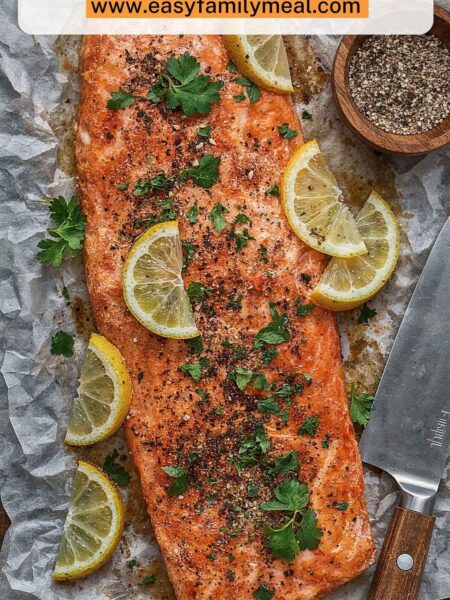Before we dive into the magic of sous vide steak, let’s talk pairings. A perfect steak deserves sides that complement its succulent flavors. Think roasted asparagus drizzled with olive oil and a sprinkle of sea salt. Grilled corn on the cob brushed with a hint of lime can elevate any plate.
A creamy garlic mashed potato is always a comforting companion. Additionally, a fresh green salad with a zesty vinaigrette brings brightness and balance. Finally, don’t forget a glass of bold red wine, like a Cabernet Sauvignon, which works beautifully with rich cuts of meat.
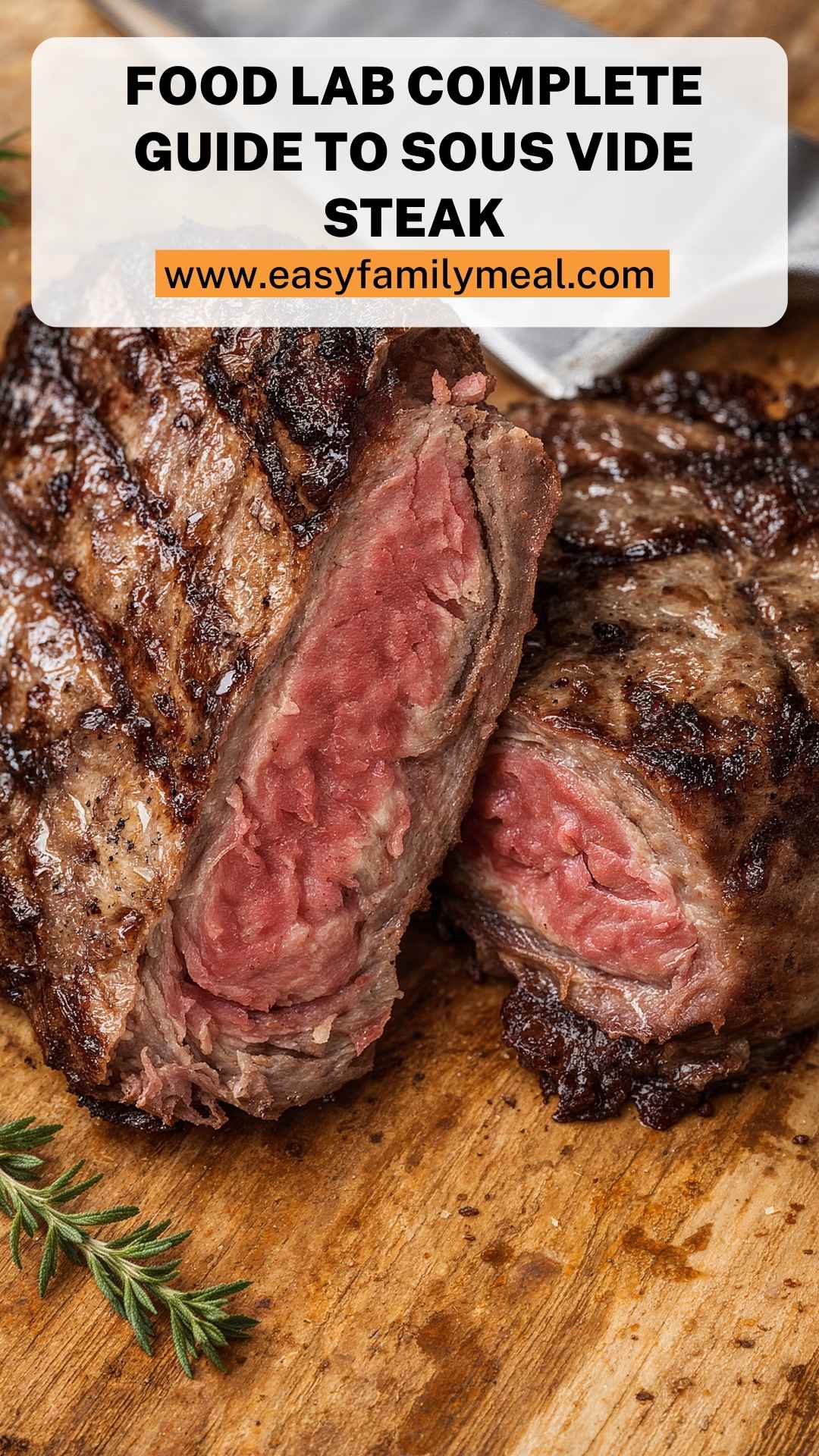
What is Food Lab’s Complete Guide to Sous Vide Steak?
At its core, sous vide means “under vacuum” in French. It involves placing food in a vacuum-sealed bag and immersing it in a water bath at a controlled temperature. This method allows for precise cooking, which results in consistent doneness throughout your steak.
Let me tell you, that’s not just a gimmick; it’s a game-changer. I stumbled upon sous vide cooking years ago when searching for a foolproof way to cook meat without the risk of overcooking. Trust me; this method changes the meat-cooking game forever.
How Does It Taste Like?
Imagine cutting into a steak that’s cooked exactly to your preferred level of medium-rare. Each slice is pink and juicy from edge to edge. The flavor is concentrated, thanks to the sealed cooking process.
While traditional methods can leave you guessing on cooking times and temperatures, sous vide ensures even distribution of heat. The result? A flavor explosion that feels indulgent but is easy to achieve. Once I tasted a sous vide steak, the days of chewy, overcooked cuts were behind me.
Why You’ll Love This?
Let’s break down the love affair. First, sous vide steak is incredibly forgiving. Whether you’re a newcomer or a seasoned cook, you won’t have to guess when your steak is ready. Second, it allows you to infuse flavors directly into the meat using herbs and spices.
Finally, because you can cook the steak ahead of time, sous vide frees you up for the rest of your meal prep. You’ll have more time to enjoy your gathering instead of being glued to the stovetop.
Ingredients
Let’s gather some essentials for our sous vide steak adventure:
- 2 ribeye, strip, porterhouse, or T-bone steaks (1½ to 2 inches thick, about 1 pound/450g each)
- Kosher salt and freshly cracked black pepper (to season generously)
- ½ teaspoon smoked paprika (optional, for subtle smoky flavor)
- 2 tablespoons high-smoke-point oil (like canola or vegetable, for pan-searing; optional)
- 2 tablespoons unsalted butter (for basting during pan-searing; optional)
- 1 tablespoon finely chopped parsley (for garnish and brightness; optional)
- 4 sprigs of fresh thyme or rosemary (for aromatic depth; optional)
- 2 large cloves of garlic, lightly crushed (optional)
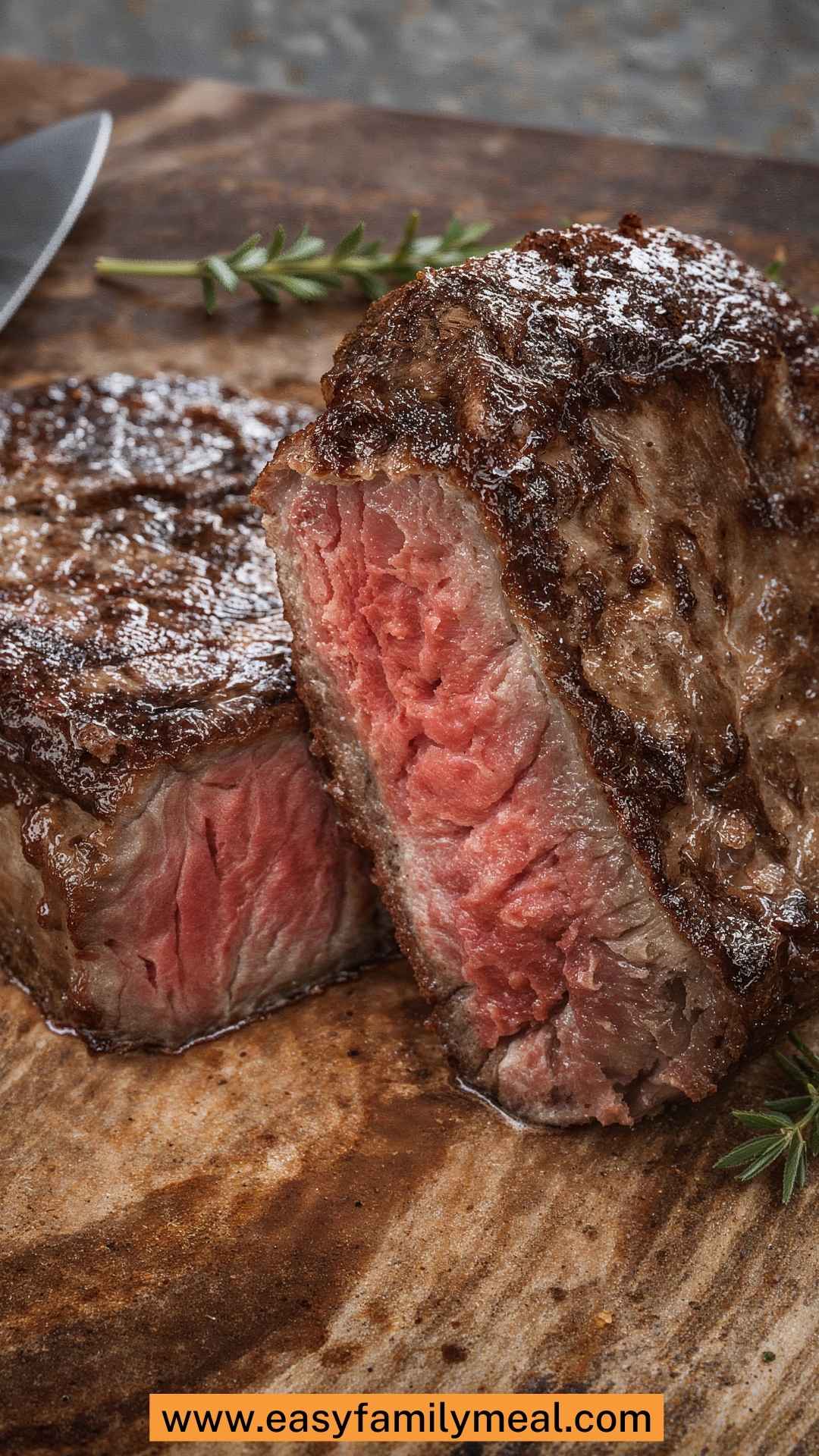
Step by Step Directions
Now, let’s get into the nitty-gritty with our step-by-step guide.
Step 1: Prepare the Steak
Start by removing your steaks from the refrigerator. Let them sit at room temperature for about 30 minutes. This helps them cook evenly. Pat them dry with paper towels to achieve a nice sear later.
Step 2: Season Generously
Generously season each steak with kosher salt and freshly cracked black pepper. You can sprinkle some smoked paprika for an added smoky flavor. If you’re feeling adventurous, toss in a sprig of thyme or rosemary and a clove of crushed garlic for extra flavor.
Step 3: Vacuum Seal the Steaks
Place each steak in a vacuum-seal bag, ensuring they fit snugly. You can also add aromatics like herbs or garlic to the bag for enhanced flavor. Use a vacuum sealer to remove the air. If you don’t have a vacuum sealer, a zipper bag with water displacement works well too — just lower the bag into water to push out the air before sealing.
Step 4: Preheat the Water Bath
Fill a pot or container with water. Attach your immersion circulator and preheat it to your desired steak temperature. For medium-rare, aim for 130°F (54°C); for medium, go for 140°F (60°C).
Step 5: Cook the Steak
Once the water has reached the desired temperature, immerse your sealed bags of steak. Cook for 1 to 4 hours based on your preferences. The beauty of sous vide is that longer cooking times don’t dry out the steak; they enhance tenderness.
Step 6: Sear for Perfection
After cooking, remove the bag from the water bath and take out the steak. Pat them dry again. Preheat a skillet over high heat. Add some high-smoke-point oil and place the steaks in the skillet. Sear for 1-2 minutes per side for a beautiful crust. Add unsalted butter and baste the steaks for extra richness.
Step 7: Rest and Serve
Let your steaks rest for a few minutes before slicing. This allows juices to redistribute. Serve with a sprinkle of chopped parsley for a fresh touch. Slice and serve to the delighted guests at your table.
Tips on Making Food Lab’s Complete Guide to Sous Vide Steak
- Choose Quality Meat: Select high-quality steaks. Look for well-marbled cuts for the best flavor.
- Experiment with Seasonings: Don’t hesitate to play with flavors. Try different herbs and spices to suit your taste.
- Avoid Overcooking: Even though sous vide is forgiving, it’s best to stick to the recommended cooking times for optimal doneness.
- Use a Good Sear Technique: When searing, make sure your skillet is hot enough to get that beautiful golden crust. Lack of heat leads to steaming rather than searing.
- Keep Equipment Clean: Ensure your equipment, especially bags, is maintained. Preventing cross-contamination will give you safe, delicious results.
Nutrition Information
For a 1-pound ribeye steak cooked sous vide without added oils or fats, the nutritional breakdown is approximately:
- Calories: 790
- Protein: 62g
- Fat: 58g
- Carbohydrates: 0g
This might vary based on the specific cut and added ingredients. For the best results, always calculate according to the specifics of your cuts and side dishes.
How Do You Store This Food Lab’s Complete Guide to Sous Vide Steak?
Proper storage is key. After cooking, if you have any leftovers, let the steak cool slightly. Seal it in an airtight container or the original vacuum-sealed bag. Store it in the refrigerator for up to three days. If you plan to keep it longer, freeze it; it will retain its quality for 2-3 months. When it’s time to enjoy again, thaw in the refrigerator overnight before reheating in a water bath or skillet for that fresh-cooked flavor.
What Other Substitutes Can You Use in Food Lab’s Complete Guide to Sous Vide Steak?
If you’re looking to switch things up, try these options:
- Filet Mignon: For a leaner cut with tender texture. It’s classy and rich in flavor.
- Flank Steak: Perfect for marinating. It’s versatile for tacos or salads.
- Sirloin Steak: A more affordable cut that still yields great results when cooked sous vide.
- Pork Chops: Yes, you can sous vide other meats! These become incredibly moist and flavor-packed.
- Chicken Breast: For a leaner option, chicken breast turns out juicy and tender when cooked sous vide.
Feel free to explore! Each of these substitutions can provide a unique taste profile and experience.
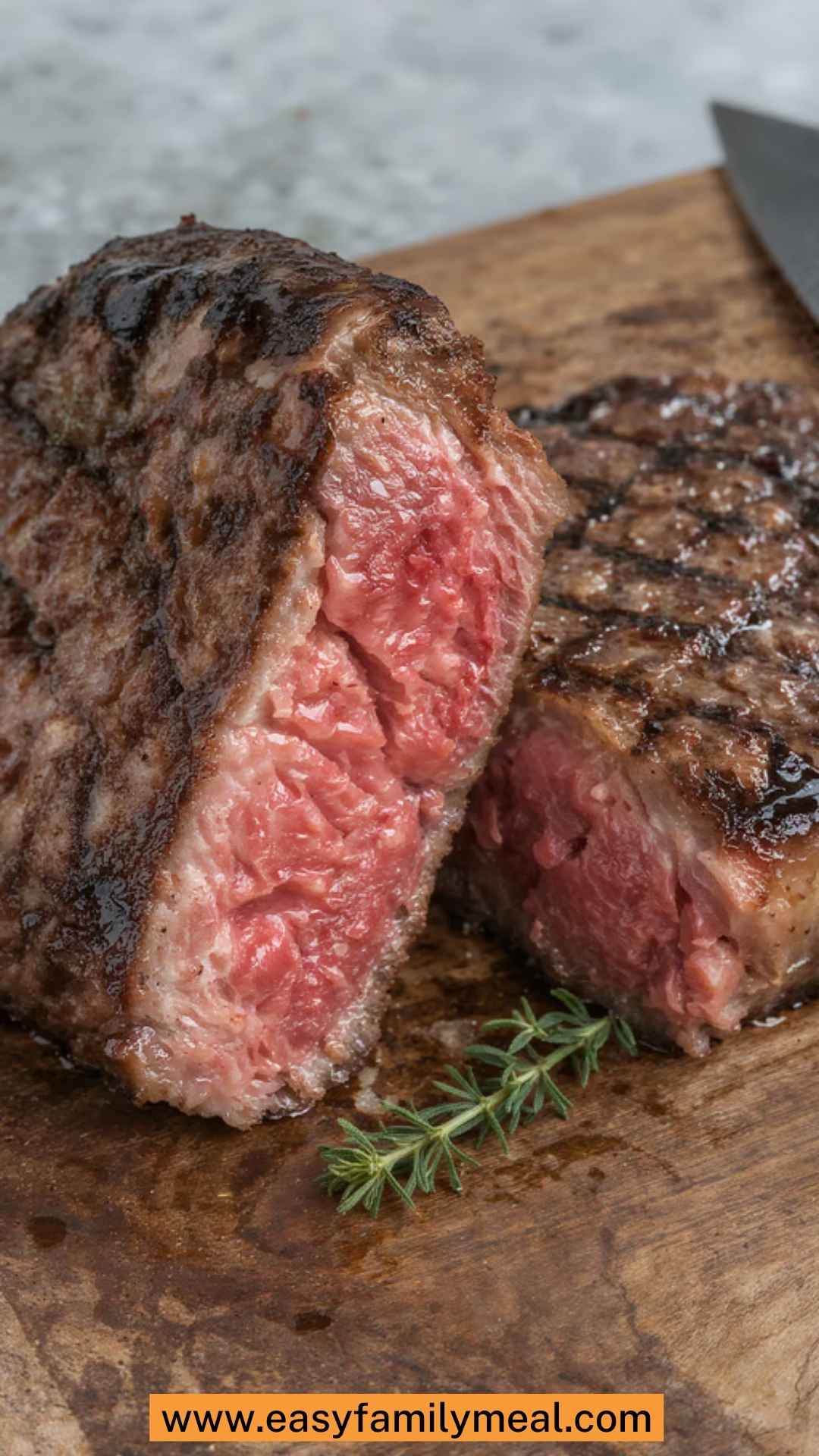
Conclusion
Now that you’ve ventured through this guide and gained the keys to sous vide steak, you’re all set to impress at your next dinner. Whether you stick to classic ribeye or branch out to other meats, the technique will elevate your culinary prowess. With a focus on flavors and perfect doneness, sous vide is your ticket to mastering steak. Let your creativity shine, and make that next meal a memorable one. Remember, the best dinners don’t just satiate hunger; they spark joy and create lasting memories. Happy cooking!
You’ll also like the following recipes!
- Stovetop Mac and Cheese Recipe
- Basic Rotisserie Chicken Recipe
- Classic Margarita Recipe Tequila Cocktail
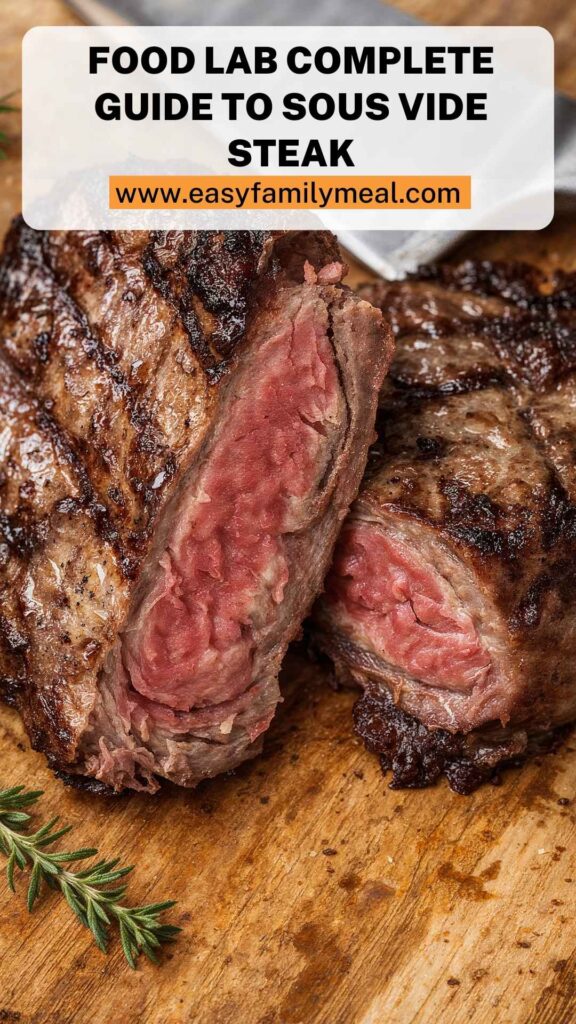
Food Lab Complete Guide To Sous Vide Steak – Easy Family Meal
Description
Sous vide doesn’t sound like your average cooking technique, right? It’s not about tossing ingredients into a pot and calling it dinner. Instead, it’s a method that brings precision and perfection to the table. Picture this: a perfectly cooked steak, tender and juicy, with every bite echoing the flavors you love.
Intrigued? You should be! Today, I’m sharing my complete guide to sous vide steak, revealing everything from the basics to gourmet-level insights. Get ready to enhance your culinary skills and impress your friends and family.
Ingredients
Instructions
Step 1: Prepare the Steak
-
Start by removing your steaks from the refrigerator. Let them sit at room temperature for about 30 minutes. This helps them cook evenly. Pat them dry with paper towels to achieve a nice sear later.
Step 2: Season Generously
-
Generously season each steak with kosher salt and freshly cracked black pepper. You can sprinkle some smoked paprika for an added smoky flavor. If you’re feeling adventurous, toss in a sprig of thyme or rosemary and a clove of crushed garlic for extra flavor.
Step 3: Vacuum Seal the Steaks
-
Place each steak in a vacuum-seal bag, ensuring they fit snugly. You can also add aromatics like herbs or garlic to the bag for enhanced flavor. Use a vacuum sealer to remove the air. If you don’t have a vacuum sealer, a zipper bag with water displacement works well too — just lower the bag into water to push out the air before sealing.
Step 4: Preheat the Water Bath
-
Fill a pot or container with water. Attach your immersion circulator and preheat it to your desired steak temperature. For medium-rare, aim for 130°F (54°C); for medium, go for 140°F (60°C).
Step 5: Cook the Steak
-
Once the water has reached the desired temperature, immerse your sealed bags of steak. Cook for 1 to 4 hours based on your preferences. The beauty of sous vide is that longer cooking times don't dry out the steak; they enhance tenderness.
Step 6: Sear for Perfection
-
After cooking, remove the bag from the water bath and take out the steak. Pat them dry again. Preheat a skillet over high heat. Add some high-smoke-point oil and place the steaks in the skillet. Sear for 1-2 minutes per side for a beautiful crust. Add unsalted butter and baste the steaks for extra richness.
Step 7: Rest and Serve
-
Let your steaks rest for a few minutes before slicing. This allows juices to redistribute. Serve with a sprinkle of chopped parsley for a fresh touch. Slice and serve to the delighted guests at your table.
Nutrition Facts
Servings 6
- Amount Per Serving
- Calories 790kcal
- % Daily Value *
- Total Fat 58g90%
- Protein 62g124%
* Percent Daily Values are based on a 2,000 calorie diet. Your daily value may be higher or lower depending on your calorie needs.
Note
- Choose Quality Meat: Select high-quality steaks. Look for well-marbled cuts for the best flavor.
- Experiment with Seasonings: Don’t hesitate to play with flavors. Try different herbs and spices to suit your taste.
- Avoid Overcooking: Even though sous vide is forgiving, it's best to stick to the recommended cooking times for optimal doneness.
- Use a Good Sear Technique: When searing, make sure your skillet is hot enough to get that beautiful golden crust. Lack of heat leads to steaming rather than searing.
- Keep Equipment Clean: Ensure your equipment, especially bags, is maintained. Preventing cross-contamination will give you safe, delicious results.



